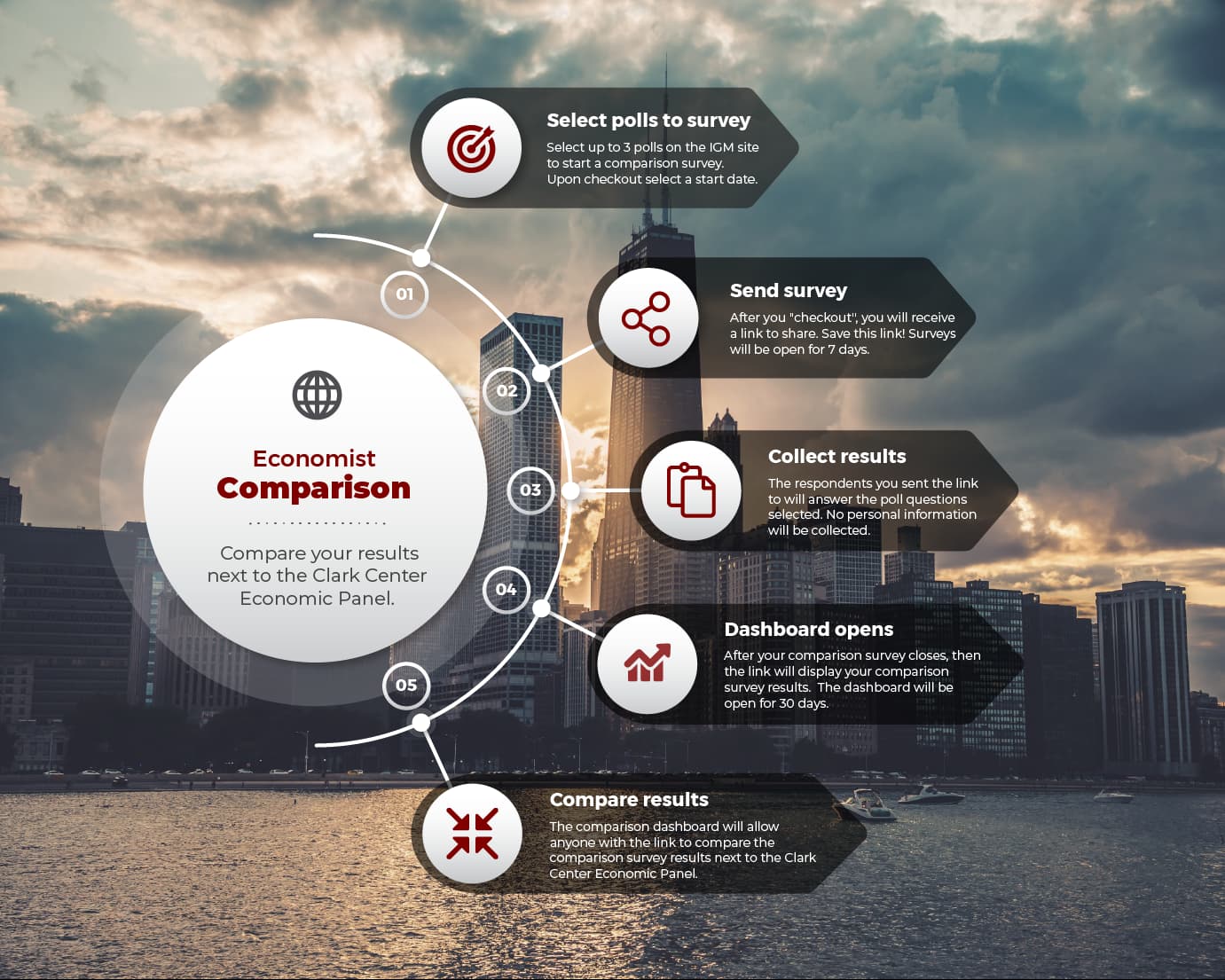Question A:
A bipartisan bill to cap credit card interest rates at 10% has been introduced recently in the House and the Senate: https://ocasio-cortez.house.gov/media/press-releases/ocasio-cortez-luna-introduce-bill-cap-credit-card-interest-rates-10
Capping credit card interest rates at 10% would make most users measurably better off.
Responses
© 2025. Kent A. Clark Center for Global Markets.
10%
0%
26%
44%
18%
3%
0%
Responses weighted by each expert's confidence
© 2025. Kent A. Clark Center for Global Markets.
32%
53%
12%
3%
0%
Question B:
Capping credit card interest rates at 10% would lead to a substantial reduction in access to credit for low-income borrowers.
Responses
© 2025. Kent A. Clark Center for Global Markets.
10%
0%
3%
0%
5%
54%
28%
Responses weighted by each expert's confidence
© 2025. Kent A. Clark Center for Global Markets.
4%
0%
4%
59%
33%
Question A Participant Responses
Participant |
University |
Vote |
Confidence |
Bio/Vote History |
|---|---|---|---|---|
 John Campbell |
Harvard | Bio/Vote History | ||
|
Relatively few borrowers will experience lower rates while retaining credit access and experiencing no increase in other card costs. A better approach would be to cap late payment fees, which have very high implicit APRs.
|
||||
 John Cochrane |
Hoover Institution Stanford | Bio/Vote History | ||
|
Confidence not 100% because banks and credit card issuers are not as competitive as they should be, thanks to regulatory protection. Still, capping rates is most likely to lead to the same profits, less credit, and more fees.
|
||||
 Francesca Cornelli |
Northwestern Kellogg | Did Not Answer | Bio/Vote History | |
|
|
||||
 Douglas Diamond |
Chicago Booth | Bio/Vote History | ||
|
|
||||
 Wenxin Du |
HBS | Bio/Vote History | ||
|
|
||||
 Darrell Duffie |
Stanford | Bio/Vote History | ||
|
With no accompanying credit access rules, this would likely imply low card credit for low-income consumers.
|
||||
 Janice Eberly |
Northwestern Kellogg | Bio/Vote History | ||
|
The high-credit-quality borrowers who obtain a 10% credit card borrow little, so they benefit little. Where would those shut out of a 10% card shift? - small loans or credit competitive with cards, or more expensive alternatives. Empirically, available credit tends to contract.
|
||||
 Eugene Fama |
Chicago Booth | Bio/Vote History | ||
|
Question is too vague. Depends on what you mean by "most."
|
||||
 Xavier Gabaix |
Harvard | Bio/Vote History | ||
|
Disclosure is good, to avoid traps; but not interest rate caps / price controls.
-see background information here |
||||
 Itay Goldstein |
UPenn Wharton | Bio/Vote History | ||
|
|
||||
 John Graham |
Duke Fuqua | Bio/Vote History | ||
|
|
||||
 Campbell R. Harvey |
Duke Fuqua | Bio/Vote History | ||
|
Those that are paying 20%+ interest might seem to be better off in the short-term - but they might find their credit line cut or their card cancelled in the future. Further, other fees might be imposed.
|
||||
 Harrison Hong |
Columbia | Did Not Answer | Bio/Vote History | |
|
|
||||
 Wei Jiang |
Emory Goizueta | Did Not Answer | Bio/Vote History | |
|
|
||||
 Steven Kaplan |
Chicago Booth | Bio/Vote History | ||
|
|
||||
 Anil Kashyap |
Chicago Booth | Bio/Vote History | ||
|
|
||||
 Ralph Koijen |
Chicago Booth | Did Not Answer | Bio/Vote History | |
|
|
||||
 Camelia Kuhnen |
UNC Kenan-Flagler | Bio/Vote History | ||
|
|
||||
 Andrew Lo |
MIT Sloan | Bio/Vote History | ||
|
Supply and Demand
|
||||
 Michelle Lowry |
Drexel LeBow | Bio/Vote History | ||
|
Key question is what else would change. First, more people might decide to carry credit card debt instead of getting other loans(estimated 56% people currently pay off their bill each month)? Second, more people might rely on loan sharks, bc they would be denied credit cards.
|
||||
 Sydney Ludvigson |
NYU | Bio/Vote History | ||
|
|
||||
 Matteo Maggiori |
Stanford GSB | Bio/Vote History | ||
|
|
||||
 Gregor Matvos |
Northwestern Kellogg | Bio/Vote History | ||
|
|
||||
 Tobias Moskowitz |
Yale School of Management | Bio/Vote History | ||
|
Price restrictions on credit result in quantity restrictions and since borrowers were willing to borrow at the higher price, they will clearly be worse off.
|
||||
 Stefan Nagel |
Chicago Booth | Bio/Vote History | ||
|
It's possible than many users would gain net from reduced markups, while (possibly large) surplus losses concentrated among a smaller number of users who lose access to credit
|
||||
 Jonathan Parker |
MIT Sloan | Bio/Vote History | ||
|
Capping interest rates shuts many people out of credit markets, and a 10% cap -- far below the market average -- would cut out many riskier and harder-to-serve potential borrowers, pushing them into shadow debt markets or shutting them out of emergency borrowing.
|
||||
 Christine Parlour |
Berkeley Haas | Bio/Vote History | ||
|
Quantity adjustments are the natural consequence of price controls
|
||||
 Thomas Philippon |
NYU Stern | Bio/Vote History | ||
|
|
||||
 Manju Puri |
Duke Fuqua | Bio/Vote History | ||
|
|
||||
 Michael R. Roberts |
UPenn Wharton | Bio/Vote History | ||
|
|
||||
 Paola Sapienza |
Hoover Institution Stanford | Bio/Vote History | ||
|
There will be lots of potential borrowers who will be cut out of the market. The question ask about "most users." Some users may be better off, but not most.
|
||||
 Amit Seru |
Stanford GSB | Bio/Vote History | ||
|
Borrowers may face additional fees, or some lenders might withdraw from the market entirely. Ultimately, it comes down to the outside options available for the most constrained or risky borrowers.
|
||||
 Robert Stambaugh |
UPenn Wharton | Bio/Vote History | ||
|
|
||||
 Laura Starks |
UT Austin McCombs | Bio/Vote History | ||
|
|
||||
 Jeremy Stein |
Harvard | Bio/Vote History | ||
|
|
||||
 Johannes Stroebel |
NYU Stern | Bio/Vote History | ||
|
|
||||
 Sheridan Titman |
UT Austin McCombs | Bio/Vote History | ||
|
|
||||
 Stijn Van Nieuwerburgh |
Columbia Business School | Bio/Vote History | ||
|
Market clearing interest rate may be well above 10% for some groups who would then lose access to credit.
|
||||
 Toni Whited |
UMich Ross School | Bio/Vote History | ||
|
|
||||
Question B Participant Responses
Participant |
University |
Vote |
Confidence |
Bio/Vote History |
|---|---|---|---|---|
 John Campbell |
Harvard | Bio/Vote History | ||
|
Low-income borrowers often have low credit scores that make card issuers unwilling to lend at rates below 10%.
|
||||
 John Cochrane |
Hoover Institution Stanford | Bio/Vote History | ||
|
Banks are almost sure to tighten credit standards, and send less financially secure people off to payday lenders or underground. AOC et al might try to force cross-subsidies, as Congress does with medicine, which will just screw things up more.
|
||||
 Francesca Cornelli |
Northwestern Kellogg | Did Not Answer | Bio/Vote History | |
|
|
||||
 Douglas Diamond |
Chicago Booth | Bio/Vote History | ||
|
|
||||
 Wenxin Du |
HBS | Bio/Vote History | ||
|
|
||||
 Darrell Duffie |
Stanford | Bio/Vote History | ||
|
With no other rules for credit provision, many low-income consumers would probably be denied card credit.
-see background information here |
||||
 Janice Eberly |
Northwestern Kellogg | Bio/Vote History | ||
|
The magnitude "substantial" is hard to know since firms will innovate and provide other products, depending on the economic and regulatory environment. So other things equal, credit declines, but innovation could provide other forms of credit.
|
||||
 Eugene Fama |
Chicago Booth | Bio/Vote History | ||
|
|
||||
 Xavier Gabaix |
Harvard | Bio/Vote History | ||
|
|
||||
 Itay Goldstein |
UPenn Wharton | Bio/Vote History | ||
|
|
||||
 John Graham |
Duke Fuqua | Bio/Vote History | ||
|
|
||||
 Campbell R. Harvey |
Duke Fuqua | Bio/Vote History | ||
|
Cards will not be issued to high-risk borrowers if the rate is capped at 10%.
|
||||
 Harrison Hong |
Columbia | Did Not Answer | Bio/Vote History | |
|
|
||||
 Wei Jiang |
Emory Goizueta | Did Not Answer | Bio/Vote History | |
|
|
||||
 Steven Kaplan |
Chicago Booth | Bio/Vote History | ||
|
|
||||
 Anil Kashyap |
Chicago Booth | Bio/Vote History | ||
|
|
||||
 Ralph Koijen |
Chicago Booth | Did Not Answer | Bio/Vote History | |
|
|
||||
 Camelia Kuhnen |
UNC Kenan-Flagler | Bio/Vote History | ||
|
|
||||
 Andrew Lo |
MIT Sloan | Bio/Vote History | ||
|
Lowest credit quality borrowers are the first to be excluded from credit markets because lenders have no incentive to lend to them with a 10% cap, given their default rates.
|
||||
 Michelle Lowry |
Drexel LeBow | Bio/Vote History | ||
|
|
||||
 Sydney Ludvigson |
NYU | Bio/Vote History | ||
|
|
||||
 Matteo Maggiori |
Stanford GSB | Bio/Vote History | ||
|
|
||||
 Gregor Matvos |
Northwestern Kellogg | Bio/Vote History | ||
|
|
||||
 Tobias Moskowitz |
Yale School of Management | Bio/Vote History | ||
|
There is a lot of evidence on this, going back centuries.
-see background information here |
||||
 Stefan Nagel |
Chicago Booth | Bio/Vote History | ||
|
|
||||
 Jonathan Parker |
MIT Sloan | Bio/Vote History | ||
|
|
||||
 Christine Parlour |
Berkeley Haas | Bio/Vote History | ||
|
|
||||
 Thomas Philippon |
NYU Stern | Bio/Vote History | ||
|
|
||||
 Manju Puri |
Duke Fuqua | Bio/Vote History | ||
|
|
||||
 Michael R. Roberts |
UPenn Wharton | Bio/Vote History | ||
|
|
||||
 Paola Sapienza |
Hoover Institution Stanford | Bio/Vote History | ||
|
|
||||
 Amit Seru |
Stanford GSB | Bio/Vote History | ||
|
|
||||
 Robert Stambaugh |
UPenn Wharton | Bio/Vote History | ||
|
|
||||
 Laura Starks |
UT Austin McCombs | Bio/Vote History | ||
|
|
||||
 Jeremy Stein |
Harvard | Bio/Vote History | ||
|
|
||||
 Johannes Stroebel |
NYU Stern | Bio/Vote History | ||
|
|
||||
 Sheridan Titman |
UT Austin McCombs | Bio/Vote History | ||
|
|
||||
 Stijn Van Nieuwerburgh |
Columbia Business School | Bio/Vote History | ||
|
|
||||
 Toni Whited |
UMich Ross School | Bio/Vote History | ||
|
|
||||

